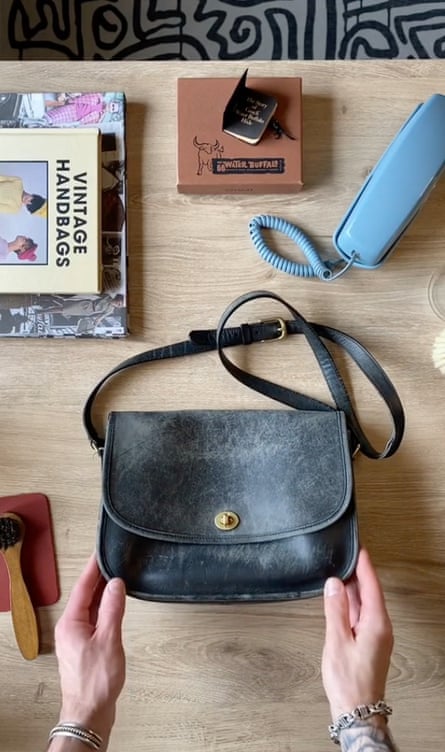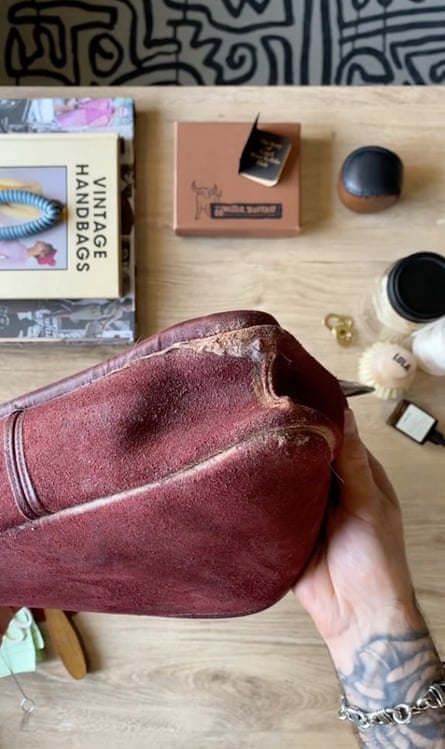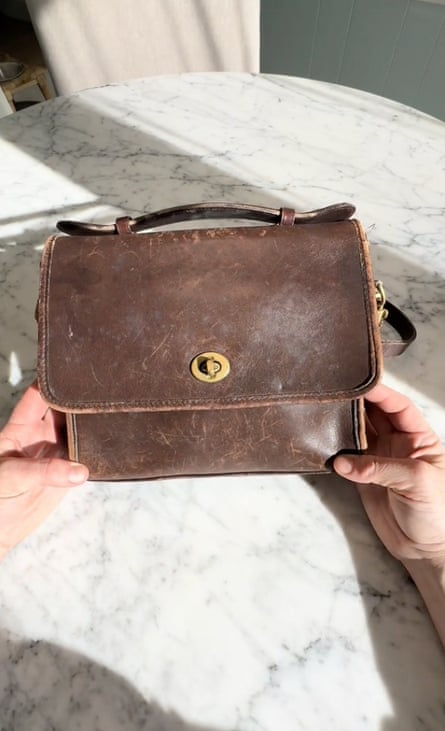
‘Let’s give her a relaxing spa day’: how to restore a leather handbag at home
Handbag rescue videos are one of TikTok’s most wholesome, soothing trends. And as a professional handbag repairer confirms, the results are achievable at home too
An hour into researching this piece I found myself on the resale platform Depop looking for vintage Coach bags. It’s not the first time writing about fashion has brought me close to buying something, but in this instance my desire came from a new place.
I didn’t just want a bag, I wanted a beat-up leather bag from the 1980s (when Coach was still made in New York) so I could try and restore it following the instructions of the videos I’d seen on TikTok. Watching someone thoroughly clean and condition an old leather bag till it’s plump and smooth, while they calmly explain what they’re doing, is so incredibly satisfying I wanted to experience it myself.
On social media, the trend has largely been focused on Coach bags because of an account started in 2021 by Will Tyler under the handle @willdernesstyler. His videos have tens of millions of views, and dozens of other TikTok users have followed his advice to repair their own handbags, or op-shop finds.
While I scrolled for vintage Coach on my phone, I had tabs open on my computer for the products he recommends – saddle soap, a horsehair brush and leather conditioner. If I was purchasing a fixer-upper, I figured I should be prepared when it arrived (spoiler: I did not buy the Coach bag).

Coach bags from that era were made with full-grain leather and solid brass hardware, materials that respond well to a little bit of care but are by no means exclusive to Coach. The techniques used can easily be applied to leather bags from other brands – in Australia, vintage Oroton would work nicely – and in a variety of styles.
Tyler did not respond to requests to comment for this piece, but I cross-referenced his techniques with advice from Jessica Jarrett, the operations manager of SoleHeeled, a professional shoe and handbag repairer, on the best way to restore leather handbags at home.
Step one: clean the inside

The first (and most satisfying) step is to clean the inside of the bag. This can be done by turning it inside out and using the upholstery attachment on your vacuum cleaner to thoroughly remove any crumbs, lint and dust. If the inside of the bag has pilled, Tyler will often use a shaver to smooth it out.
Step two: clean the outside
Next, turn the bag the right way again and stuff it with tissue paper or a rolled-up towel, so it holds its shape while you clean the outside. For this step, Tyler uses Fiebings saddle soap, which is specific to leather, but Jarrett recommends Angelus Easy Cleaner, which can be used on various kinds of leather, including suede and nubuck as well as canvas, plastic and rubber.

Whatever cleaner you decide to use, be sure to test it first. Jarrett says apply it to “a small, inconspicuous area to ensure it doesn’t cause any staining or discolouration”, and only proceed to clean the rest of the bag if the leather looks OK once it has dried.
Use a horsehair brush, some water and small circular motions to apply the leather cleaner. It should work up a lather. Remove it by wiping down each part of the bag with a damp cloth.
Step three: condition
To restore the leather’s natural oils, which keep it nourished and supple, it will need to be conditioned. When the bag is still slightly damp from being cleaned, Tyler applies a conditioner called Leather CPR to the bag with his hands, carefully massaging it into the seams and corners. For any areas that need additional care he uses Chamberlain’s Leather Milk healing balm.
after newsletter promotion
“We use GE-WY leather conditioner,” says Jarrett. “If the leather is suede or nubuck, then a specialist suede brush should be used to restore the nap on the leather’s surface.”
If the leather is particularly dehydrated, sometimes more than one layer of conditioner needs to be applied. Often this has to be spread out over days so that each layer of conditioner is fully absorbed between applications.
Step four: remove scratches and discolouration
“Lighter surface scratches and scuffs can often be buffed out using leather wax polishes and creams,” says Jarrett. These products help reduce the visibility of marks by restoring the leatherʼs colour and patina. “For customers with an eye for detail, Saphirʼs range of Medaille d’Or Pate de Luxe produces the best results.”

Tyler avoids using products with dyes in his restorations but occasionally applies Renapur Leather Balsam or Absorbine Leather Therapy to help even out the colour and provide a little shine. This is applied by hand and then buffed with a clean horsehair brush.
If the leather has deep scratches and heavy discolouration, Jarrett says repairs are best left to an expert since “messing it up can irreversibly damage the leather”.
Step five: polish the hardware
Often the buckles and clasps on vintage bags are tarnished, scratched or have accumulated gunk around them. Depending on the quality of the metal, it is possible to give them a refresh. One of the most soothing parts of Tyler’s videos is watching him prize the hardware open to remove it from the bag so he can brush away the dirt that’s accumulated underneath. He then uses a buffing block and some Brasso to make the hardware shiny again (although removing the hardware felt like something I probably wouldn’t be game to try myself).
Jarrett also suggests a specialist metal polishing cream and a polishing cloth for lighter scratches, but she says that for deeper scratches it’s best to get an expert to do the more abrasive polishing to smooth the metal’s surface and re-plate it to restore its colour.
Step seven: fix loose threads
A popular tip from Tyler that I’ve seen used by other bag repairers on TikTok– always with a note to thank him – is for repairing loose or broken stitches. Jarrett describes it as the “snip and singe” method.
“It involves using a pair of fine scissors to cut the thread no more than a few millimetres from the leatherʼs surface and then using a lighter to burn the remaining loose thread,” she says. Since most thread is made from polyester, the heat causes it to melt so it can be pressed and sealed flat into the seam.
How to find a fixer-upper

If you want to make thrift-flipping handbags a hobby, Jarrett recommends paying close attention to what the bag is made from. “Genuine leather is far more durable and easier to maintain and refresh than most other materials, particularly synthetic leathers,” she says.
The next thing to consider is the extent of wear and tear. Generally speaking, bags with minor cosmetic issues such as discolouration around the bottom corners are easy to restore, but structural issues such as sagging or creased leather will require more work and expertise, so might not be worth the trouble.
Source: theguardian.com



